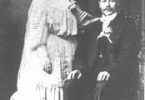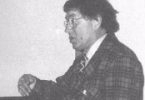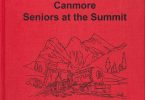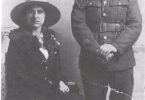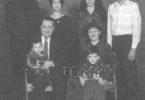Although I was born in Winnipeg, my family brought me to Alberta when I was six weeks old. We lived on a ranch at Edgerton, near Wainwright, until I was five. Then we moved to Olds where my dad, F.F. Parkinson, joined the staff of the Olds School of Agriculture, now Olds College. He was manager of the Demonstration Farm and taught Mathematics, Physics and Farm Machinery during the winter courses. My mother, Harriette (Evans) Parkinson provided a warm, loving home for Dad, my three brothers and me, besides being active in community affairs such as Home and School, I.O.D.E. and the United Church.
All my school years were spent in Olds and when I finished high school, I thought of joining the Forces as WW II was on. However, my high school principal and my family convinced me that I would be doing as valuable war service if I became a teacher, as there was a great shortage of teachers. My training was under the War Emergency Teacher Training Program which meant that about seventy of us went to Normal School (teacher training college) for July and August to receive consolidated courses on handling Grades One to Nine because there were still many ungraded classrooms in rural communities and that was where the greatest need for teachers existed. The first of September, we were out in charge of schools. Mine was west of Wetaskiwin, southeast of Pigeon Lake, where I had thirty-eight pupils in eight grades. As I had never attended an ungraded classroom, it was a learning experience for all of us!- a lot of midnight oil! At the end of six months, members of another class of trainees came out to take over our school and we returned to Normal School for three months. We then graduated with Temporary Elementary and Intermediate Teaching Certificates which were made permanent after we attended two Summer Schools at the University of Alberta (no U. of C. yet).
I then taught in several rural schools in Alberta, finally returning to teach Grade Five in Olds the year after the end of the War. Next, I attended O.S.A. to take the Home Economics course before attending U. of A. in the Faculty of Home Ec. During those two summers, I worked in Banff at Gus Baracos’s Banff Cafe and that is where I first met Bob when he came in looking for his friend, Andrew Baracos. We did some hiking and exploring around the Park, our first date being the walk up the zigzag trail to the top of Sulphur Mountain with four friends, to be at the top for the sunrise.
After my first year at U. of A., I ran out of money (no student loan available) so I returned to teaching, realizing a long-standing dream of going into the Far North. I became the teacher at Port Radium on the southeast shore of Great Bear Lake, the Eldorado Mining and Refining Ltd. uranium mine. Again, I had an ungraded classroom but never more than fourteen pupils. They were all children of company employees as the local native people were never encouraged to become dependent on the mine. Being designated a Welfare Teacher, I had responsibilities for numerous other activities such as a once-a-week kindergarten, running the library and supervising all recreation within the community. This included such things as curling in winter, monthly dances, amateur dramatics, fishing derbies in summer, photo club, etc. We were not really isolated as there was twice-weekly plane service from Edmonton winter and summer, with only about six weeks in fall for freeze-up and another six for spring breakup when we were without planes. With a hospital, resident doctor and nurses and Army Signals station for communication, we never felt completely cut off.
Because I liked the recreation work, after two years I took a job as Dean of Residence and Director of Recreation for Student Nurses at the St. Catharines General Hospital in St. Catharines, Ontario. I soon realized they only wanted a policeman for the Nurses Residence as the girls all went home if they had any time off from work or studies. However, I stayed the year of my contract, using my time off to visit relatives in southern Ontario, and Montreal, Quebec.
When I left St. Catharines, I learned that there was an opening for a teacher at Port Radium again so I applied, got the job and returned for another two years. Through all these years, Bob and I had kept up our friendship through correspondence and an occasional meeting. Then at Easter, 1953, we became engaged and were married in September that year. We settled in Seebe where Bob worked for Calgary Power Ltd., now TransAlta Utilities.
I first came to Canmore the summer of 1939 with my “cousin” Jessie. My Aunt Mollie (Mrs. Harriet Mary Heath) took Jessie into her family at Bankhead when Jessie’s mother died when she was only eighteen months old. Her father, Sandy Nichol, would never allow Aunt Mollie to adopt her. He had very little contact with her through the years but, in 1939, invited her to come to Canmore for a visit. Jessie asked me to come with her. We had a nice week seeing Canmore and Banff and meeting Sandy’s friends here.
My next visit was in 1946 when friend and I stopped to visit Aunt Mollie who was teaching in Canmore, having returned to teaching during WW II. On both these occasions, we went up to Twin Lakes, now Grassi Lakes.
After Bob and I were married, we sometimes came here to see movies in the Canmore Opera House but other than that, were not often in Canmore. Our two daughters were born in Calgary, Marjory in 1955 and Shirley in 1957. Marjory, now Mrs. Greg Gibney, is the librarian at Lawrence Grassi School and has two children, Eleanor and Kevin. Greg is a technical operator with TransAlta. Shirley, after dancing (ballet) professionally for ten years, is now living in Halfmoon Bay, B.C., with her husband, David Jackson, and their two girls, Astrid and Tegan. David is a marine stationary engineer.
The years in Seebe were busy and happy with many family and community activities. When Shirley was four years old, I was called upon to do some substitute teaching in Exshaw and continued that on a sporadic basis until a year or two after we moved to Canmore. The Seebe Community Club was very active. Bob and I helped form the Seebe Camera Club, later Bow Valley Camera Club, and we joined Bow Valley Naturalists as soon as it was organized. I helped Dolly Moore a couple of years with the interdenominational Sunday School which met on a weekday after school, but my major undertaking was to qualify as a Red Cross Swimming and Water Safety Instructor and then to teach swimming classes for sixteen summer. Once Shirley began her ballet training in Calgary, Bob or I drove thousands of miles, taking her to Calgary for classes. Marjory went along on Saturdays for her flute lessons.
On family holidays, we travelled through much of southern Alberta and B.C., once to Ontario and Montreal, and once to the Maritimes, often camping. Our last big camping trip was to Yellowknife, N.W.T., where we found it difficult to sleep in a tent with almost 24-hour daylight!
1967, Centennial Year, was cause for many special activities. Elena Torn and I organized a Hobby Fair for the children; the children, with help from adults, decorated a Calgary Power truck to enter the July 1st Parade in Canmore and won a prize; the Halloween dance, always a masquerade, became the Centennial Ball with everyone dressing as a personage from Canada’s 100 year history. Bob and I personally developed a slide show titled simply “CANADA” which we showed in many places, including Canmore.
Also, in late 1967, Bob and I helped organize a new Canadian photographic organization, the National Association for Photographic Art. In 1975, Bob was chairman of the N.A.P.A. annual convention, held in Banff, and I was his unofficial secretary. Together over the years, we did several photo seminars and other slide presentations throughout western Canada and in Spokane and Seattle.
In 1978, TransAlta Utilities gave permission for employees to live as far away from Seebe as Canmore so we bought our home here, as did several other couples (the houses in Seebe were all owned by TransAlta and not for sale). We moved on December 1, 1978.
At that time, the population of Canmore was about 3,000 and we soon felt that we knew most of the people we met on the street. The Post Office was a vital meeting place even when it was in the small building now occupied by The Corner Gallery. That is one of the things we really miss since Canada Post decreed that we should have community mail kiosks.
Soon after we moved here, Reverend Bill Thwing convinced me that I should write a 90-year history of Ralph Connor Memorial United Church. Working with committee, I began collecting information locally and each time I went to Edmonton, I spent some time in the Provincial Archives doing research. Finally, in 1983, it was completed. I have continued to be active in various capacities at the church, such as being a member of the Board, and of the Centennial Committee in 1991, as well as continuing to be church Historian.
At the Seniors Drop-In Centre, I sang with the Norman Witham Singers for a number of years and enjoyed the various programs we provided, especially the many different things in which we took part during Canmore’s Centennial Year, 1983. We dressed in old-fashioned costumes several times that year, adding colour to the festivities. In 1992, I helped with the “mellerdrammer”, NO, NO, A MILLION TIMES NO, when one of the singers could not continue.
My father died in 1979 in Edmonton and in January, 1980, Mother moved into the Bow River Senior Citizens Lodge. During the eight years she lived there, and then two years in Extended Care, I helped with some activities for the residents. One very interesting project in Extended Care was the making of Finnish mats as it used to be done by the wives of the early Finnish miners here. Mother passed away in February, 1990, just four days after her 93rd birthday.
The Bow Valley Camera Club voted itself out of existence in December, 1978, but Bob and I joined the Canmore Artists and Artisans Guild in 1980 and show photographic prints there. As well, we carry on our other photography interests such as giving slide shows. Our 50-year collection of slides proved useful in showing the many changes in the valley up to 1992 when it was shown at the Natural Resources Conservation Board hearings and numerous times on local TV. We have both been members of BowCORD (Bow Valley Organization for Responsible Development) since it was organized and are still active in B.V.N.
Through the 1980’s and until her death in 1995, I did a lot of driving and gave other help to Miss Eleanor Luxton of Banff and now am a member of the Board of Directors of the Eleanor Luxton Historical Foundation.
The 1988 Winter Olympic Games had a tremendous impact on Canmore and spread its name around the world via TV coverage. Among other activities, we hosted Lise and Harold Daudrich, the parents of Lorna Sasseville, a Canadian cross-country skier, through the Adopt-A-Parent Program. The notable legacies of the Games are the Nordic Centre, Bill Warren Training Centre, the Curling Rink (used as the dining centre) and the swimming pool. I continue to use the pool, swimming regularly.
We continue to feel privileged to live in Canmore with its beautiful surroundings, but are saddened to see the uncontrolled development that is choking the valley. Game trails and hiking trails are being cut off and we are losing some of the attributes that should be attractions to visitors and locals alike.
Robert Neville (Bob) Smith
Biography for CSA History Book 1999
I was born in the Nightingale Nursing Home in Banff, on March 27, 1926. I grew up at Lake Minnewanka, where my father, Enoch Smith, was the superintendent of the old Cascade Power Plant. This was a small hydro plant that only supplied power to the town of Banff and a few outlying buildings and homes, such as the Sun Greenhouse at Anthracite.
Dad was an electrical engineer and had installed small hydro plants in northern Ontario, but came west to Melville, Saskatchewan, where he and his brother opened a hardware store. He returned to Melville after the war, having risen to the rank of Major, but was then hired by the Dominion Government to build the hydro plant at Minnewanka in 1923-24. The project was urgent as the mine at Bankhead was about to shut down and with it, the coal-fired power plant which provided Banff’s electricity. Dad liked the mountains so much that he applied for the job of plant superintendent when the plant was completed, and got it. He promptly sent a telegram to Laurene Munson, a Melville school teacher to whom he was engaged, to come to Calgary, where they were married in June, 1924, by the Reverend Rex Brown. I was born two years later.
Growing up at Lake Minnewanka seemed quite a normal thing to me at the time, but I now realize that I had a very special and privileged childhood. It was a lonely one, but this never bothered me as I was resourceful at entertaining myself, exploring the woods and nature, imagining the cliffs and rock outcroppings around home were castles to defend or attack, and that the animal trails in the dense woods were my secret passages and roads. I was a voracious reader and gained an interest in a large number of subjects. I also developed a lot of hobbies, so I never felt that I SHOULD be lonely. Until I was about thirteen, I was the only kid in the neighbourhood.
My first recollection of Canmore would be from 1929 or 30, when my parents used to visit their friends, Mr. and Mrs. Francis and their daughters, one of whom was named Leona. Mr. Francis was, I believe, an electrical engineer with the Canmore Mines, but I am uncertain of this. They later moved to Brentwood Bay on Vancouver Island, and when we dropped by to visit them in 1937, they had moved away, and we never heard from them again.
I went to school in Banff, and in good weather would ride my bike the seven miles to school, then Mom or Dad would pick me up in the evening, usually about 5:00 O’clock, so I had lots of time to play with my friends after school, a special time in my lonely existence. The next day, they would drive me in the morning, and I would ride the bike home at night. With a one-speed, and a carrier full of homework, the old Bankhead Hill was a terror!
In winter, the road to Banff would often be drifted in for long periods while we waited for the Park grader to come and plow us out. As a result, Mother and I would sometimes have to move into town for January and February.
My school-day recollections of Canmore were via hockey games and sports meets. We always considered the Canmore kids to be “tough”, and their skill at hockey was legendary. They ALWAYS beat Banff, it seems to me, except for one memorable occasion when Banff won. I can’t remember if the Canmore people were mad at the refereeing or if they were just sore because, unbelievable as it no doubt was, Banff had won. As the bus-full of the Banff team and fans pulled out for home, it was hit with a barrage of stones, one of which broke a window, but no one was hurt.
This did not particularly endear Canmore to the Banff kids. I was a klutz at hockey, though a great fan of the Red Wings because my uncle, Goldwyn (Goldie) Smith was their western Canada scout. I enjoyed track events more, and was an enthusiastic though very mediocre high jumper, broad jumper, and hurdler. The Canmore kids we met at Sports Days seemed a friendlier sort than the hockey players.
Canmore did not play any part in my life during high school. The war was on and our spare time (and much of our school time) was taken up with Air Cadets. My dad was insistent that I take a year of college before I joined the regular forces, so when I was through school at 18, I went to Mount Royal College in Calgary for 1944-45. While there, I was in the reserve army and spent many evenings and weekends drilling at the Mewata Armories. It seemed to us kids that the war was going to go on forever, and we would have lots of time to “shop around” for the service we liked best. Just before exams in the spring of 1945, several of my pals and I went up to HMCS Tecumseh and joined the navy. This excitement completely overshadowed our exams, and I fear, none of us did very well.
Before we received our call-ups, VE Day came along and recruits were put on hold. I got a job with Calgary Power Company at Seebe, but then along came VJ Day, and that was that. I went on permanent staff with Calgary Power (now TransAlta) and remained with them until my retirement in 1986.
In my first year with Calgary Power, I became really quite well acquainted with Canmore via the Canmore Hotel beer parlour. A bunch of the fellows coming back from the forces to Seebe were a pretty lively bunch and I regularly went gadding up to the Canmore pub with them, in spite of being under age. No one ever challenged me for ID. The drinking age then was twenty-one, and I was nineteen. Now the fifteen and sixteen year olds are bluffing their way into the pubs, with the legal age down to eighteen.
Among the Canmore people I remember from those days, Mrs. Mary Rodda stands out clearly. She and her husband had owned the Canmore Hotel for years, and after his death, she continued on as part owner. When things started to get rowdy in the beer parlour, and it looked as though there might be a fight, she would saunter in and sit down at one of the contentious tables and say something like, “Well, hello Jack, how are you? And how is your dear mother coming along? I heard that she has been quite ill” …etc., etc. The belligerent Jack or whoever would promptly deflate from a pug ugly to a reasonable, polite human being and the rising tensions evaporated. However, fights were a regular thing at the hotel, and Mrs. Rodda was not always on hand to defuse them.
My acquaintance with Canmore remained more or less of the party scene until after Mary Parkinson, from Olds, Alberta, came into my life. Mary came to work as cashier at the Banff Cafe in the summer of 1947, when she was going to university. I was a pal of Andrew Baracos, the son of Gus Baracos, proprietor of the cafe and had gone to see Andy to plan a hike to the top of Sulphur Mountain to see the sunrise. A couple of other Seebe fellows, Dave Zilm and Warrender Robertson and their girls were already booked up to go. We got chatting with Mary and asked her if she would like to join us, and so a climb to the top of Sulphur in the wee small hours was our first date. Mary got a job teaching in the Northwest Territories at Port Radium on Great Bear Lake. So, though we kept in touch by letters, we saw little of each other for the next few years. In 1953, Mary came out of the North for Easter, and I proposed; she accepted and we were married in September of that year. Our daughter, Marjory, was born in March, 1955, and our second child, Shirley, in June, 1957.
Canmore started to come into our lives more and more as time went on. The Spray Hydro Project was completed and a lot of our Seebe friends were transferred up there and became “Canmorons”. Among the first to live at Spray Village were Joyce and Keith Cole. Keith was the first Spray superintendent; Joyce was born Joyce Staples, and her parents had been the gatekeepers at the Park Gate when it was located at Kananaskis, the village at the Loders Lime Plant (now Continental Lime) east of Exshaw. After the death of Mr. Staples, Mrs. Staples continued as head gatekeeper for many, many years, through its various relocations and up to the present site west of Canmore. Other Spray folks were George and Marie Atkinson. They still live here, and of their family, their daughter Judy remains here also, as a school teacher and the wife of artist Michael Vincent. Frank and Barbara Wright were also Spray employees. When they first moved to Canmore, there were not enough houses built to accommodate all the staff, so they lived in a little cabin on Railway Avenue, owned by Mrs. Summerhays. That is where I first met Mrs. Summerhays’ daughter, Goldie, and her husband, Walter Latvala. Bill and Bev Maxwell were early Spray folks, too, as were Walter and Connie Desrochers. Bev and Bill moved on to Brazeau Hydro Plant where Bill was superintendent, and they retired to Powell River, B.C. Bev just passed away in April of 1999 and Bill still lives at Powell River. The Desrochers left Calgary Power in the mid-50’s and moved to Toronto, where Walter joined Ontario Hydro. They have retired there. Frank and Barbara Wright moved to the thermal plants at Wabamun. Barbara passed away many years ago.
Keith and Joyce Cole still reside in Canmore and are in their 80’s. Joyce and Keith were keen photographers and nature lovers. Joyce was also an accomplished artist and a potter. In 1958, the Coles founded the Seebe Camera Club. There were several keen photographers in Seebe, including ourselves. This began as a Calgary Power club, but soon others, all the way from Lake Louise to Cochrane, were asking if they could join, and so we changed the name to the Bow Valley Camera Club. Among the Canmore people who were in the club, besides just about the whole staff at Spray Plant, were postmaster Nick Trofimuk and his wife Dorothy, Andy Dalgleish, Emyr and Olive Jones, and Elizabeth Rummell (who seldom took a photo but who was our most sensitive and constructive critic). Canmore artist, Duncan Crockford, C.P.R. photographer Nick Morant and artist Nick de Grandmaison from Banff were among those who came to judge competitions, give us advice and regale us with their tales. All three were great raconteurs.
The Bow Valley Camera Club became one of the top camera clubs in Canada and some of our members also became active in international saIons, winning medals and many acceptances all over the world. A few of us went on to sell our pictures commercially to magazines, calendars, reference books and “coffee table” art books. Some of us have work in the National Museum of Photography in Ottawa.
The club, as a whole, regularly placed among the top ten camera clubs in Canada in both pictorial and nature photography. Nature was our strongest point, and the Coles and the late Bill deHaan were our top stars in that department. The club folded in 1978, after twenty years of great fun, comradeship and serious learning of the art of photography. The reason for the demise of the club was because the same group of people had been on the executive all through those twenty years, and no one would spell us off. We just got burnt out, as it was a very active and high powered club. Banff people who were in the club and later moved to Canmore were Bill and Isobel deHaan, and Mary Paris. Bill deHaan was one of our hardest working executive members and also a joy to have as a member and friend due to his great good humour. Many Canmore people will remember Mary and Cyril Paris, who owned the Paris Cafe in Banff, as did Cyril’s father before him. When Cyril died, Mary moved to the Lodge in Canmore. She was one of our best scenic photographers. She, too, is now gone.
Our medical connection in Canmore began at Christmas, 1963, when our little nephew, Chris, from Montreal, took sick. We rushed him up to the old Canmore Hospital on the hill where we were met by Dr. Rooks, who put Chris to rights in short order. We had always gone to Calgary or Banff for medical services, but after that, Canmore became our choice. Two of our grandchildren, Eleanor and Kevin Gibney, were born in the old hospital in 1980 and 1983.
Another Canmore connection in the Seebe years was through the United Church. Mary was a member, and while I was not, we both enjoyed doing various projects with Reverend Tom Jones and his wife, Renah. I worked with them setting slides to music that Tom chose for the Christmas and Easter services, and to the poetry by Renah that interwove through the sermon and the music. This led to our being asked to give slide presentations to the schools, Boy Scouts, Rotary Club, etc. We were also among the members of the first Canmore Historical Society, which later evolved into the Centennial Museum Society.
In 1978, Calgary Power finally realized that forcing employees to reside in company housing in Seebe, so that they would be on hand for emergencies, was unrealistic and unfair. Employees at the Calgary Trouble Headquarters in downtown Calgary lived as far away as Okotoks and Airdrie, and had to cope with downtown traffic en route to emergency calls. So, after the first big jump in Canmore real estate prices, we were finally allowed to move here. Too bad it had not been a few years earlier!
Seebe was a great place to live and bring up children. It was more like a great big family than a town and the community spirit was superb. However, no one could own their own houses there, so it was with little regret that we finally moved to Canmore.
Canmore has also been a wonderful place to live, and though we are “relative newcomers” to town, having just been here twenty-one years, our connections with the town in the past makes it feel as though it has been part of “home” for many decades more.
The Bow Valley Camera Club has been replaced in our lives by the Canmore Artists and Artisans Guild, in which we have been given life memberships and still regularly exhibit our photography. We also continue to give slide shows for clubs and charities, and slide lectures and presentations for environmental causes. Our slide show was used regularly on the local cable TV in the winter of 1991-92 and as a part of the Natural Resources Conservation Board hearings in 1992. I have set myself an ongoing task of photographing and describing the botany of the Bow Corridor for albums in the reference section at the Canmore Library.
I was on the Board of the Canmore Library in the early ’80’s and was chairman for part of that time, and was on the Canmore Museum Board for a few years. We have been heavily involved with the Bow Valley Naturalists for nearly thirty years. I also served on the Environmental Assessment Review Committee for the Town of Canmore, and have been a member of BowCORD since its inception in 1992. One of my greatest pleasures, though, has been as a hike leader with “The Meanderthals”, the wonderful hiking group that was started by Pamela Grigg in 1993. This group has been so popular that we have become victims of our own success, with over 100 hikers, and thus the need to have sign-up sheets and several hikes per week in order to keep the groups to a pleasant and manageable size, and to appeal to a variety of interests and abilities. I also lead short nature hikes on Monday evenings through the summer. This group was dubbed “Walk, Talk and Gawk” by our former United Church minister, Malcolm Proffit. I am on the Board of the Eleanor G. Luxton Historical Foundation, as is my wife, Mary.
It hurts to see over-development spoiling this beautiful valley. It is a physically confined space that does not allow for a full-fledged city and wilderness to exist in the same area; yet, that is exactly what is happening, with wildlands, birds and animals being the losers. Despite the protests of a large number of residents, both old and new, the pressure continues to build. But, when we ask ourselves, “Where would we like to live if Canmore continues to cut off access to its beautiful surroundings?”, we can think of no place of great natural beauty and nearness to the natural world that is not suffering the same abuse. So, we are going to be “Canmorons” for the rest of our days, and are grateful for the privilege of having spent our lives here. We have lived most of our lives in the very best of times and in the best area in the world.

Mary and Bob Smith 1997

Bob and Mary Smith and Family 1998
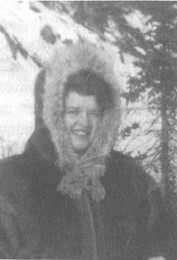
Mary in Port Radium wearing caribou parka 1952

Bob Smith on Devil’s Bridge, downstream from 1912 dam at Lake Minnewanka, about 1935
In Canmore Seniors at the Summit, ed. Canmore Seniors Association, 2000, p. 266-273.

